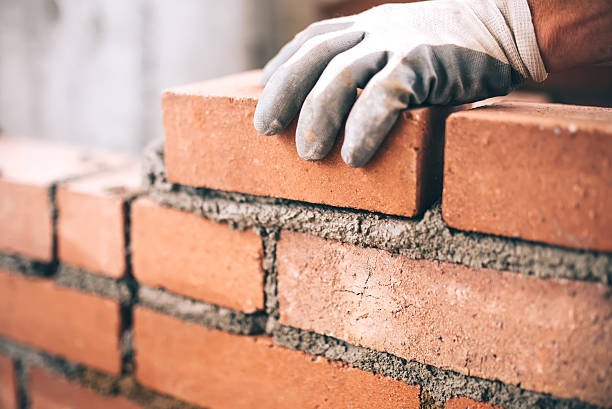Unlocking the Secrets of Lasting Stonework Building And Construction Practices for Eco-Friendly Buildings
Among the myriad approaches to environmentally friendly building, lasting stonework building and construction stands out as a time-tested and resilient technique that holds a riches of untapped possibility. From the choice of products to cutting-edge building strategies, the tricks to attaining sustainability within masonry building and construction are multifaceted and interesting.
Advantages of Sustainable Masonry Construction
Welcoming lasting masonry construction practices not just minimizes ecological effect but also supplies lasting financial advantages to home builders and areas. By making use of products like recycled blocks, blocks, and stones, builders can considerably decrease the carbon footprint of their tasks while advertising resource efficiency. Additionally, lasting masonry building techniques, such as correct insulation and thermal mass buildings, can boost energy efficiency within structures, bring about lowered functional expenses gradually.
Additionally, the longevity and durability of masonry frameworks add to lasting financial advantages. Buildings constructed making use of sustainable masonry practices often require less upkeep and fixing, converting to set you back financial savings for builders and building proprietors. The long life of stonework materials additionally makes sure that frameworks stay steady and safe, decreasing the need for frequent renovations or replacements.
Eco-Friendly Stonework Products
Making use of environmentally friendly masonry materials is an essential action in the direction of enhancing the sustainability of building techniques and minimizing environmental effect while maximizing lasting economic advantages. Lasting stonework materials are sourced, generated, and used in a fashion that reduces total ecological impact. Lasting concrete obstructs include recycled aggregates and may include enhanced insulation buildings, contributing to energy performance in buildings.
Moreover, all-natural materials like adobe, rammed planet, and straw bundles provide excellent thermal mass homes, reducing the need for home heating and cooling down energy. These materials are often locally readily available, advertising local economic situations and lowering transportation-related carbon discharges. By choosing green stonework products, building and construction projects can significantly lower their ecological impact and add to the production of much healthier, much more sustainable built settings.
Energy-Efficient Stonework Methods
Energy performance plays an important function in improving the sustainability of masonry building and construction techniques. One crucial energy-efficient stonework method is the use of thermal mass, which includes incorporating dense materials like concrete or brick right into the structure's framework to take in and keep heat.

Advancements in Sustainable Masonry
Current improvements in sustainable stonework practices have actually caused innovative strategies that are reshaping the building sector. One such advancement is the development of self-healing concrete, which uses bacteria installed within the concrete to recover splits autonomously. This development not only reduces maintenance prices but view it additionally improves the resilience of stonework structures, contributing to their sustainability.
Another significant innovation is using recycled accumulations in stonework construction - masonry contractor. By integrating products such as crushed ceramic waste or recycled glass right into concrete mixes, builders can minimize the environmental effect of building and construction projects while preserving architectural integrity. This method not just draws away waste from landfills however additionally conserves all-natural sources, making it a key improvement in lasting stonework construction
Moreover, the combination of electronic style devices, such as Building Information Modeling (BIM), is reinventing the means stonework structures are prepared and created. BIM enables more exact estimations, reduced material wastage, and improved energy effectiveness, eventually resulting in more sustainable structure techniques. These technologies jointly symbolize an appealing future for lasting masonry construction in the era of environmentally friendly structures.
Future Trends in Stonework Sustainability
With the ingenious strides made in lasting masonry techniques, the future trends in stonework sustainability are positioned to more reinvent the building industry. Among the crucial patterns shaping the future of stonework sustainability is the boosted combination of innovation. Improvements such as find Building Information Modeling (BIM) and digital truth simulations are being utilized to maximize stonework construction procedures, causing decreased product waste and enhanced energy performance in buildings.
In addition, the advancement of novel lasting materials is readied to play a considerable role in improving the eco-friendliness of masonry building and construction. masonry contractor. Advancements like self-healing concrete, recycled aggregates, and bio-based binders are obtaining traction for their capacity to lessen environmental effect while maintaining architectural stability

Conclusion
In verdict, lasting masonry building and construction practices provide countless benefits for environment-friendly buildings. By using green materials and energy-efficient methods, stonework can add to an extra lasting built environment. Advancements in lasting stonework are continuously being developed to even more improve the environmental performance of buildings. Looking in the direction of the future, the pattern of stonework sustainability is anticipated to grow, causing even more eco-friendly and energy-efficient building and construction practices in the years to come.